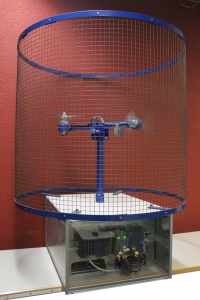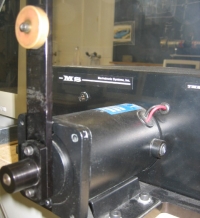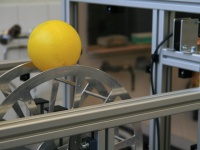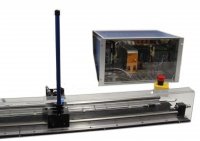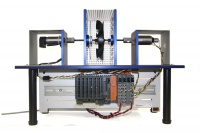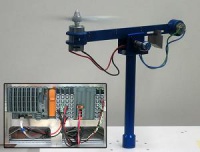Experiments
Experiments in the Autumn Semester
On this page you will find short descriptions of every experiment we offer. You can also download the manuals and necessary files for your homework preparation from here.
Registration: Please register for experiments on the D-ITET online registration website.
Please note that the Covid Certificate is mandatory for Laboratory Courses at ETH. You can find all the complete safety protocol for IfA Control laboratories below:
Safety Concept
1.4 Helicopter I - Fuzzy Logic
Use fuzzy logic to create a controller for a model helicopter. Take advantage of the human friendly, rule based technique to control any system that is difficult to describe mathematically. Ignore the internal structure of the model (Black Box), instead control the helicopter by only studying the behavior of the inputs and the outputs. Simulink will be used to develop the fuzzy controller.
Prerequisites
Basics of feedback control, in particular:
- The idea of feedback (RS1 §§ 4.1-3; weeks 3-4)
Homework
Preparation time approx 1.5 hrs, see Manual.
Place
Downloads
1.9 Ranger - Inverted Pendulum
Ranger is a pendulum system with one degree of freedom. Get to know the basic properties of a PID controller on this simple, yet highly dynamic system. A graphical user interface will guide you step-by-step through the process. Learn more about topics like the Nyquist-criterion, dead-time and crossover frequencies. Be careful though, Ranger can get nasty if your controller is unstable!
This is an experiment supervised by IDSC and only available on Friday
Prerequisites
- PID (RS1 § 4.4; week 4)
- Lead-Lag Compensator
Homework
Preparation time approx 2 hrs, see Manual.
Place
Downloads
1.10 Ball on Wheel
This experiment consists of a wheel that is actuated by an electric motor. A ball has to be balanced on top of it whereby the position of the ball is measured by a laser sensor. You design two controllers to stabilize the ball and allow for reference tracking of the wheel's speed: The first controller consists of two cascaded SISO-loops whereas the second controller is a MIMO-controller.
This is an experiment supervised by IDSC and only available on Friday
Prerequisites
- Basics of linear system theory (RS1 §§ 2.5, 3.1, 16.2; weeks 2-3, 10-11)
- LQG/LTR (RS1 § 17.9; week 13)
Homework
Preparation time approx 2 hrs, see Manual.
Place
Downloads
2.2 Self Erecting Inverted Pendulumg - LQR
In this experiment, a pendulum is mounted on a cart. The pendulum shall be controlled to stay in its unstable equilibrium, i.e. the upright position. You will design an LQR controller to achieve this goal. Additionally, you will implement a destabilizing controller that will make the pendulum swing up from its stable downward position. Finally, the two controllers will be combined to yield a self-erecting pendulum.
Prerequisites
- Linear Quadratic Regulator
Homework
Preparation time approx 2.5 hrs, see Manual.
Place
Downloads
2.4 Speed Control - Ziegler-Nichols (PID)
Design and analyze a P-, PI- and PID controller for speed control of a DC motor drive. You will develop a model of the system in Matlab, which you can use afterwards to visualize step responses of the plant. The design of the controller follows the Ziegler-Nichols tuning rules. Validate the model by applying a reference step to both the model and the system. Since the control action is limited (i.e. the current you may feed to the motor), you will observe windup effects in the closed-loop systems. This is a very common situation for real plants.
Prerequisites
- Basics of PID control (RS1 §§ 4.4, 5; week 4)
Homework
Preparation time approx 1.5 hrs, see Manual.
Place
Downloads
2.6 Helicopter II - Lead/Lag
You will control the two coupled axes of a helicopter model. First the model of the plant is calculated and then linearized. Using Matlab and Simulink, you will design a compensation controller (Lead/Lag), which can then be tested on the real system.
Prerequisites
Lead/Lag Compensators
Homework
Preparation time approx 2.5 hrs, see Manual.
Place
Downloads
2.7 Air Ball
In this experiment the height of a ball suspended in an air tube will be controlled. A fan at the bottom of the tube causes upward airflow that pushes the ball up to counteract the downward force of gravity. The fan speed can be controlled to change the air stream velocity, causing a change in ball height. A PID controller will be designed to follow reference trajectories of the ball height and reject disturbances. You will learn the basics of PID control and understand the effects of changing the controller gains.
Prerequisites
- none
Homework
Preparation time approx 1 hrs, see Manual.
Place
Downloads
3.4 Quad Tank
The quad-tank system is a relatively simple MIMO (multi-input, multi-output) system. MIMO systems are inherently more difficult to control than systems with only one input / output. In this experiment, you will learn some fundamental techniques to control a MIMO system, like coupled- and decoupled designs or LQR / LQG state-space controllers.
Prerequisites
- Basics in MIMO control
- Minimum/Non-minimum phase plants
- PI control
- LQR control
Homework
Preparation time approx 2.5 hrs, see Manual.
